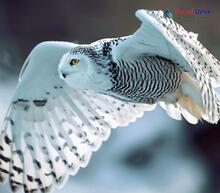The Bubo genus, commonly referred to as the true owls or eagle owls, is an intriguing and complex group of birds. With its rich history and unique features, the Bubo genus has captivated the interest of scientists and bird enthusiasts alike. This article will delve deep into the origin, evolution process, fossil records, characteristics of the Bubo genus, and their presence in Nepal.
Origin and Evolution Process
The Bubo genus belongs to the Strigidae family and is thought to have originated around 50 million years ago. As with many species, the evolutionary process of these birds can be traced through fossils and DNA studies. Scientists believe that the Bubo genus might have diverged from a common ancestor shared with other owls like the Tytonidae family during the Paleogene period.
Fossil Record
Several ancient fossils have been discovered over the years which shed light on the evolutionary history of these magnificent birds. For instance, a fossil from Germany dates back to 24-16 million years ago (Miocene epoch) provides valuable evidence about their early adaptation to hunting techniques. Other key fossils discovered in France, Switzerland, and North America also contribute significantly to understanding their prehistoric life.
Characteristics
The members of the Bubo genus are easily recognizable due to their distinctive characteristics. They possess large heads with prominent ear tufts and massive talons that aid in capturing prey. Their mighty wings enable them to fly silently at great speeds while hunting for food. Additionally, they have excellent eyesight with binocular vision which allows for precise depth perception – a vital attribute for nocturnal predators.
Eagle owls tend to inhabit forests, rocky outcrops, or open habitats ranging from grasslands to arid regions. These majestic birds are mostly monogamous and form lifelong pair bonds. Their diet primarily consists of small mammals, birds, reptiles, and amphibians. The Bubo genus comprises around 21 different species which include the Eurasian Eagle Owl (Bubo bubo) and the Great Horned Owl (Bubo virginianus).
Presence in Nepal
Nepal hosts a stunning array of biodiversity – no exception are the owl species. There are records of two Bubo genus species inhabiting the rich landscapes: the Eurasian Eagle Owl (Bubo bubo) and the Brown Fish Owl (Bubo zeylonensis). The Eurasian Eagle Owl can be found in forests, rocky cliffs, and semi-open grasslands around Nepal's mid-hill regions. Their impressive wingspan of up to 6 feet captivates birdwatchers visiting the area. Brown Fish Owls typically reside along riverbanks and near marshy areas where they prey on fish and other small animals.
In conclusion, understanding the captivating story of the Bubo genus not only presents us with a fascinating glimpse into an extraordinary group of birds but also highlights the importance of biodiversity conservation. Thanks to nurturing sanctuaries like Nepal, these incredible creatures continue to thrive, providing both locals and visitors with a unique opportunity to appreciate their beauty and magnificence.




